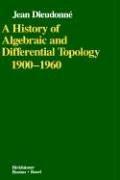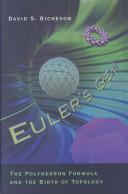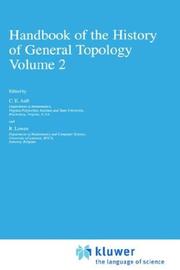| Listing 1 - 3 of 3 |
Sort by
|

ISBN: 081763388X 0817649069 0817649077 9780817633882 Year: 1989 Publisher: Boston (Mass.): Birkhäuser,
Abstract | Keywords | Export | Availability | Bookmark
 Loading...
Loading...Choose an application
- Reference Manager
- EndNote
- RefWorks (Direct export to RefWorks)
Since the early part of the 20th century, topology has gradually spread to many other branches of mathematics, and this book demonstrates how the subject continues to play a central role in the field. Written by a world-renowned mathematician, this classic text traces the history of algebraic topology beginning with its creation in the early 1900s and describes in detail the important theories that were discovered before 1960. Through the work of Poincaré, de Rham, Cartan, Hureqicz, and many others, this historical book also focuses on the emergence of new ideas and methods that have led 21st-century mathematicians towards new research directions. ***************************** This book is a well-informed and detailed analysis of the problems and development of algebraic topology, from Poincaré and Brouwer to Serre, Adams, and Thom. The author has examined each significant paper along this route and describes the steps and strategy of its proofs and its relation to other work. Previously, the history of the many technical developments of 20th-century mathematics had seemed to present insuperable obstacles to scholarship. This book demonstrates in the case of topology how these obstacles can be overcome, with enlightening results.... Within its chosen boundaries the coverage of this book is superb. Read it! —MathSciNet [The author] traces the development of algebraic and differential topology from the innovative work by Poincaré at the turn of the century to the period around 1960. [He] has given a superb account of the growth of these fields.… The details are interwoven with the narrative in a very pleasant fashion.… [The author] has previous written histories of functional analysis and of algebraic geometry, but neither book was on such a grand scale as this one. He has made it possible to trace the important steps in the growth of algebraic and differential topology, and to admire the hard work and major advances made by the founders. —Zentralblatt MATH.
Algebraic topology -- History. --- Differential topology -- History. --- Algebraic topology --- Differential topology --- Mathematics --- Physical Sciences & Mathematics --- Geometry --- History --- 515.14 --- -Differential topology --- -Geometry, Differential --- -Algebraic topology --- 515.14 Algebraic topology --- -515.14 Algebraic topology --- Mathematics. --- Differential geometry. --- History. --- Algebraic topology. --- Algebraic Topology. --- Differential Geometry. --- History of Mathematical Sciences. --- Geometry, Differential --- Topology --- Annals --- Auxiliary sciences of history --- Differential geometry --- Math --- Science --- anno 1900-1999 --- Global differential geometry. --- Algebraic topology - History --- Differential topology - History --- Geometry, Differential.

ISBN: 9780691126777 0691126771 Year: 2008 Publisher: Princeton, NJ.: Princeton university press,
Abstract | Keywords | Export | Availability | Bookmark
 Loading...
Loading...Choose an application
- Reference Manager
- EndNote
- RefWorks (Direct export to RefWorks)
Leonhard Euler's polyhedron formula describes the structure of many objects--from soccer balls and gemstones to Buckminster Fuller's buildings and giant all-carbon molecules. Yet Euler's formula is so simple it can be explained to a child. 'Euler's Gem' tells the illuminating story of this indispensable mathematical idea. From ancient Greek geometry to today's cutting-edge research, Euler's Gem celebrates the discovery of Euler's beloved polyhedron formula and its far-reaching impact on topology, the study of shapes. In 1750, Euler observed that any polyhedron composed of V vertices, E edges, and F faces satisfies the equation V-E+F=2. David Richeson tells how the Greeks missed the formula entirely; how Descartes almost discovered it but fell short; how nineteenth-century mathematicians widened the formula's scope in ways that Euler never envisioned by adapting it for use with doughnut shapes, smooth surfaces, and higher dimensional shapes; and how twentieth-century mathematicians discovered that every shape has its own Euler's formula. Using wonderful examples and numerous illustrations, Richeson presents the formula's many elegant and unexpected applications, such as showing why there is always some windless spot on earth, how to measure the acreage of a tree farm by counting trees, and how many crayons are needed to color any map. Filled with a who's who of brilliant mathematicians who questioned, refined, and contributed to a remarkable theorem's development, 'Euler's Gem' will fascinate every mathematics enthusiast.
Topology --- History --- Polyhedra. --- History. --- Polyhedra --- 515.1 --- 51 EULER, LEONHARD --- Analysis situs --- Position analysis --- Rubber-sheet geometry --- Geometry --- Set theory --- Algebras, Linear --- Polyhedral figures --- Polyhedrons --- Geometry, Solid --- Shapes --- 515.1 Topology --- Mathematics--EULER, LEONHARD --- Topology - History

ISBN: 0792350308 0792344790 9048148200 9401704686 904815023X 9401717567 9780792344797 Year: 1997 Publisher: Dordrecht: Kluwer Academic Publishers,
Abstract | Keywords | Export | Availability | Bookmark
 Loading...
Loading...Choose an application
- Reference Manager
- EndNote
- RefWorks (Direct export to RefWorks)
515.12 <09> --- 515.12 <09> General topology--Geschiedenis van ... --- General topology--Geschiedenis van ... --- Topology --- History. --- History --- Topology - History. --- Topology. --- Mathematics. --- Philosophy and science. --- History of Mathematical Sciences. --- Philosophy of Science. --- History, general. --- Science and philosophy --- Science --- Annals --- Auxiliary sciences of history --- Math --- Analysis situs --- Position analysis --- Rubber-sheet geometry --- Geometry --- Polyhedra --- Set theory --- Algebras, Linear
| Listing 1 - 3 of 3 |
Sort by
|

 Search
Search Feedback
Feedback About UniCat
About UniCat  Help
Help News
News